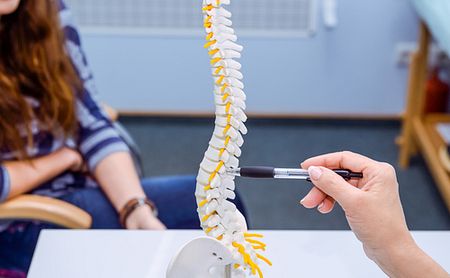#CureSMA2021 – Spinal Catheter Safe and Effective in Using Spinraza

Editor’s note: The SMA News Today team is providing in-depth coverage of the 2021 Virtual SMA Research & Clinical Care Meeting, held June 9–11. Go here to read stories from the conference.
Delivering Spinraza (nusinersen) directly into the upper spinal cord through a semi-permanent injection port overcame spinal deformity issues to safely improve upper limb speed, dexterity, and endurance in people with advanced spinal muscular atrophy (SMA) in an ongoing study.
Karlla Brigatti, research operations director for the Clinic for Special Children in Pennsylvania, presented the results of her study in a talk titled “Nusinersen by Subcutaneous Catheter for Spinal Muscular Atrophy (SMA),” at the meeting.
Biogen’s Spinraza, the first disease-modifying therapy approved for SMA, works by increasing the levels of SMN, a protein essential for motor neuron and muscle health, and whose production is largely absent or insufficient in SMA patients.
Patients receive it through an injection directly into the spine, called an intrathecal injection. Although this method can deliver the medication directly to where it is needed most, spinal deformities — scoliosis, or a sideways curvature to the spine, in particular — can complicate the procedure.
“Many patients,” Brigatti said, “have a really complex spinal pathology, extensive spinal fusions, and these anatomical challenges really complicate access to the intrathecal [inside the spinal cord] space.”
To get round this, Brigatti and colleagues at the Clinic for Special Children, along with collaborators at the Nemours/Alfred I. duPont Hospital for Children in Delaware, developed a way to perform the procedure by injecting into a port underneath the skin (subcutaneous) that empties into the cerebrospinal fluid (CSF, the fluid surrounding the brain and spinal cord).
This subcutaneous intrathecal catheter (SIC), “a hybrid infusion system using 2 FDA-approved devices,” according to the team, effectively circumvents spinal abnormalities. It was initially tested in a pilot study in 10 patients.
Brigatti described the project as “a true case of necessity being the mother of invention.”
This study has now expanded to 17 people with SMA, both children and adults.
Over two-thirds of this group are wheelchair-bound patients with advanced disease and scoliosis and/or spinal fusion, making Spinraza administration difficult through a normal spinal injection.
Study participants have now been given the medication via SIC for a median of 34 months, or early three years. Of these 17 people, 16 (94%) have what researchers described as “overt” SMA, and 15 (88%) went without treatment before entering the study.
Investigators assessed the safety of using the SIC on all 17 participants, and focused their review of its efficacy in 12 patients with mostly similar clinical characteristics, making it easier to compare results among them. These patients, evenly divided by sex, all had three SMN2 copies (SMA type 2), needed wheelchairs, were symptomatic, and all had not received treatment prior to SIC Spinraza administration. Most, 11 of these 12, also had scoliosis.
“Overall,” Brigatti said, “we found … that it was a very safe, well-tolerated, and [a] low cost means to administer [Spinraza] in a repeated outpatient setting.”
The ability to take medication through the SIC led to measurable improvements in the patients’ health.
Although general physical abilities, lung function, and electrophysiology (which measures how well nerves communicate with muscles) showed no significant changes, finger dexterity, as measured by the Nine Hole Peg Test, improved in both their dominant and non-dominant hands.
Hand grip strength also improved over the course of treatment, although this appeared to benefit most younger patients, those under age 13. Children under 10 years old and with either three or four copies of SMN2 saw their hand strength scores — measured via dynamometry — rise by 8% to 35% following their first dose of Spinraza, after which scores remained fairly stable.
The study also took into account changes in quality-of-life measures, using a combination of standardized questionnaires and personal interviews.
Patients over age 10 all reported at least one improvement in the fields of endurance, purposeful hand use, arm strength, head control, and/or speech.
Areas wherein participants felt that they experienced significant improvements, said Brigatti, “really centered around facility of their hand use, and they really found tremendous value in their improvements and things like handwriting, typing speed, [and] ability to maneuver a power wheelchair.”
“One participant in particular, she mentioned, “was delighted that he could open his own coke can.”
No serious adverse side effects were reported, relating to either accessing the SIC or administering Spinraza in an outpatient setting. Four devices needed surgical adjustments due to mechanical malfunction, and one had to be removed due to meningitis caused by a Staphylococcus epidermidis infection.
“Overall,” Brigatti concluded, “we found that this was a very safe and feasible procedure that really allows for the administration of [Spinraza],” adding that “it reduces the need for sedation [and] exposure to radiation.”
During the Q&A period, Brigatti also noted that complications related to the catheter are more likely in more severe cases of SMA.
The post #CureSMA2021 – Spinal Catheter Safe and Effective in Using Spinraza appeared first on SMA News Today.

